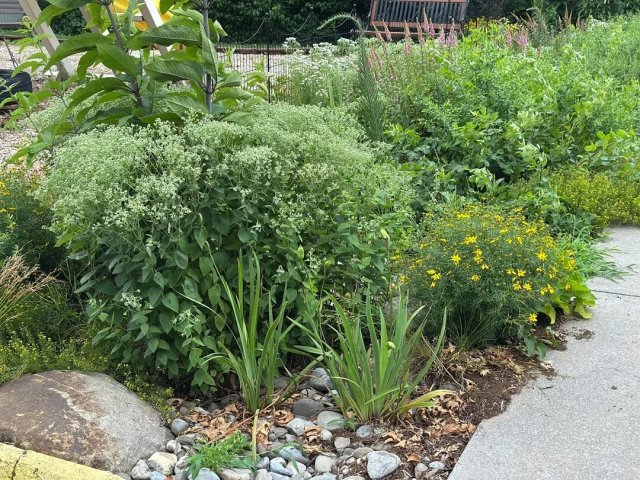One Pennsylvania homeowner has turned to a natural and aesthetically pleasing way of managing stormwater runoff — a rain garden. As the gardener’s Reddit photos show, this method became a great way to surround their home with lush greenery and colorful blooms.
 Photo Credit: Reddit
Photo Credit: Reddit
 Photo Credit: Reddit
Photo Credit: Reddit
As you can see from before and after photos, in 1.5 years, the original poster’s garden has transformed from a rocky trench to a blooming pollinator haven.
One commenter exclaimed, “What a dramatic improvement to the space! Love it!”
Capturing rainwater for your yard is a great way to conserve water and avoid flooding. According to the Florida Museum, rain gardens absorb 40% more runoff than a traditional lawn.
One savvy California gardener used their rain garden to sink over 2,000 gallons of rainwater, soaking up their yard.
Your home can become a regular meeting spot for friendly wildlife, including birds, grasshoppers, and pollinators like butterflies and bees. Providing a nesting and foraging space for pollinators helps secure the food chain, which is currently being threatened by global events, including drought, wildfires, and supply chain bottlenecks.

Want to go solar but not sure who to trust? EnergySage has your back with free and transparent quotes from fully vetted providers that can help you save as much as $10k on installation.
To get started, just answer a few questions about your home — no phone number required. Within a day or two, EnergySage will email you the best local options for your needs, and their expert advisers can help you compare quotes and pick a winner.
Luckily, sustainable gardening can help offset the effects of climate change by supporting biodiversity. Thriving native plants produce oxygen and absorb carbon before it can trap heat in the atmosphere.
There are a few steps to plan for a rain garden. Start by rewilding your yard, picking the ideal location to prevent pooling, and digging a basin to soak up the rain. Be mindful not to build it too close to your home to prevent foundation water damage.
Once you’ve built out a rain garden, most of the gardening work is done for you going forward. That’s because native plants are super low-maintenance, require less water, and are stronger thanks to deeper roots.
Of course, the rain acts as natural irrigation, saving you money on water bills. Plus, the pollinators help.
TCD Picks » Upway Spotlight
💡Upway makes it easy to find discounts of up to 60% on premium e-bike brands
If you don’t want to put in the work for a rain garden, even partial lawn replacements can reap benefits. Some have had pollinator garden success using their hellstrip — the often-neglected strip of land between the sidewalk and street.
Consider groundcovers that provide natural and beautiful mulching while also preventing runoff and erosion. Planting a native tree can bring shade, and some may bear fruit.
Not in a rain-prone area? Consider xeriscaping, which combines drought-resistant plants with your natural landscape.
Join our free newsletter for easy tips to save more and waste less, and don’t miss this cool list of easy ways to help yourself while helping the planet.


Comments are closed.